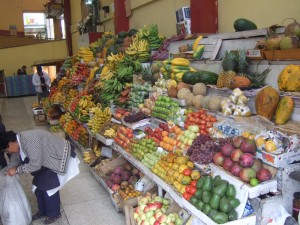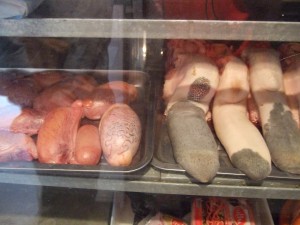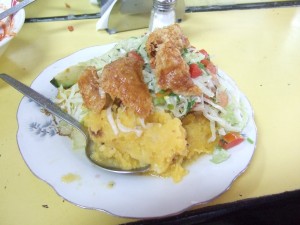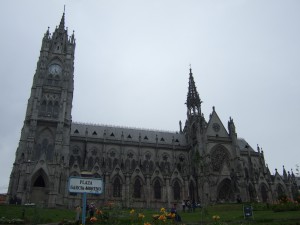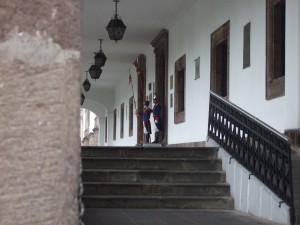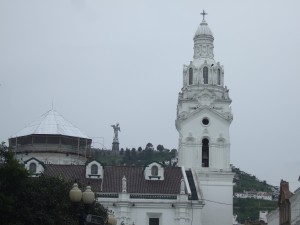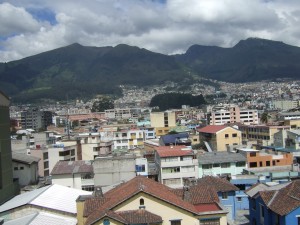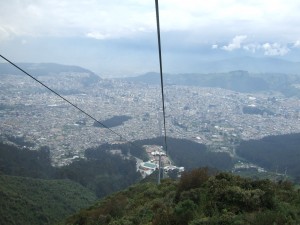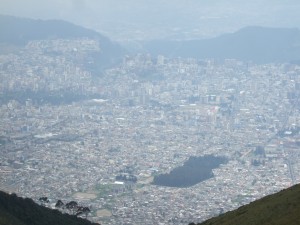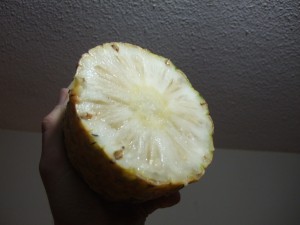Ecuador: bad rain, wonderful and terrible roads, and really good food
Entering Ecuador was relatively easy and straightforward once you got to the right places, but poorly labeled and time consuming. We got stuck there for a decent stretch of time when the border officials went to lunch and wouldn’t allow anyone into Customs. While waiting in line, we met a group of three Colombians on big Harleys also on their way to Tierra del Fuego. One rider named Oscar had spent a lot of time in the US and spoke perfect English, and they were all extremely friendly. They made it to Peru before us, and Oscar sent us a detailed email advising us on how to make the border crossing.
More impressive mountains of course, and nearly immediately we were amazed at how nice the roads were. Mostly gone were the incredibly steep, incredibly tight mountain curves. Riding a rugged mountain ridge, the mountain had been carved down 10-50 feet on either side to keep the road level, and continued that way for several miles! Drivers were also far more conscientious than they had been in Colombia and much of Central America. There were also far fewer motorcycles nearly instantly than there had been in Colombia, the reason for this becoming quickly clear upon reaching our first gas station, and confirming that unleaded was indeed $1.48 a gallon, and diesel down to a buck! Not to be too safe, not long into Ecuador we began the rain that we put up with at least once a day every day we spent in Ecuador.
Happy to be done with another long border crossing, we splurged and stopped for lunch. The only place we found open in the first town we passed sold only one thing called fritadas, so we had two orders of them. We got chunks of very tasty BBQ-ed pork served cold (probably just because of our awkward timing for lunch) with fried corn kernels, similar to what I’ve had before at Peruvian restaurants. The locals at the restaurant, as seems almost to be a tradition in Latin America, made sure they came to our table and welcomed us to Ecuador, albeit drunkenly. We ended our night in Ibarra at a decent hotel with breakfast included, and didn’t need dinner.
The next morning, we started down the road across the equator and to Quito. There was, of course, more rain and mountains, these less impressive than others we’d been through. We chose what I believed to be the correct of two routes to Quito, and came in where I’d have expected given some maps I’d looked at in the process, but we somehow managed to miss the so-called “Mitad del Mundo” – or middle of the world. Traffic worked into a frenzy as we approached Quito, but the drivers remained mostly reasonable and mostly didn’t squeeze between us inches away from spreading us across the highway.
Quito is a large, long, and skinny city, high up on a plateau and bounded to the East and West by giant volcanoes. Reaching only a little over 3 miles at its widest, and over 24 miles long, it’s divided into 3 primary areas from North to South. The north end, where we were coming in, has much of the new construction, high rises, new housing, banks, etc., the middle is the old downtown, full of old colonial and government buildings and plazas, and finally the south side is mostly residential and small commercial, the working class neighborhood. We went several miles into the north end before spotting a place called Hotel Dan, which was somehow cheaper than our hotel in Ibarra, had hot water, safe parking, giant rooms, an ancient elevator, a spa in the basement (not included), and right off the bus rapid transit line down to the city center.
John Martinez, who I’m not entirely sure how stumbled upon our blog, had emailed me some advice on Ecuador to try some local food called hornado and chochos. Not having internet at our hotel to figure out what these things were, I picked the first he’d mentioned – hornado – at random and we asked the receptionist where it could be found. The receptionist pointed us to the local market, which throughout Latin America is generally a large warehouse-like building divided into sections by shop types, and full of produce, meat, poultry, fish, handicrafts, and convenience stores, and some of the best bargain local restaurants. The receptionist gave great directions to the Santa Clara market, and we soon found ourselves in a blur of colorful shops, and unknown produce and meat
Then, into the restaurant part of the market, we saw an amazing sight…
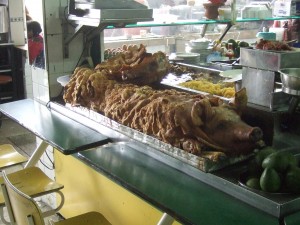
Could this full-size deep fried pig hanging out practically in the walkway of the market be hornado?
We looked up to the menu, and quickly made the connection between restaurants with giant fried pigs and those serving hornado, and ordered the basic plate, hornados with tortillas, a wallet-breaking $2.50 each:
Somehow between Central and South America, tortillas had become mashed potatos. Hornado itself was a healthy helping of amazingly tasty pork, and a couple pieces of the fried beast’s skin snapped off and served on the top of the plate. It was so unequivacally delicious that we decided to come back the next day to have it again. We also tried to pick up a white pineapple that we’d been told was similar to the yellow (on the inside) one’s we’re familiar with, but sweeter and less acidic. Though the many vegetable stands sold the stuff, they were also all sold out for the day, and told us to come back the next day. Perfect!
After lunch, we spent the $0.25 each for bus fair to the downtown and explored. I quickly found myself envying the awesome hats the indigenous people, of which there are a surprising number in Quito. We toured two very impressive churches and some large public squares. The downtown of Quito was bustling and impressive, and given its longitudinal layout, far more manageable as a tourist. There are only 3 main north-south roads, and each is easily spotted by the presence the bus rapid transit system, large buses on electric wires like in SF.
After making our rounds, we returned to the hotel and asked about the spa. It was an additional $5 each, steep by Ecuadoran prices, but we decided to check it out anyways, and were far from disappointed. The place had a sauna, steam room (full of aromatic herbs similar to our experience in Costa Rica0, and hot tub. Most of the people there were Quito natives, and had no end of fun talking to us about our trip, all while sweating profusely. We showed up in the last 45 minutes the place was open, and while the natives managed to keep the place open a bit longer, we still got booted out before we’d wanted.
That night I did some research on the internet about the things we were supposed to do in Quito, and came up with a set of things we wanted to do the next day, so we decided to stick around. First up was a tourist trap recently built called the TelefériQo, a gondola that heads up to the top of one of the volcanoes, reaching a height of 13,400 feet. Thanks to the unbelievably cheap gas and labor costs, taxis around the city were amazingly cheap, and we were amazed as the cab drove up the volcano and offered impressive views before we even started the ferry ride:
And obviously more impressive views as we climbed:
Finally, we reached the top, and had a few minutes of crisp scenery before the fog rolled in. Like pretty much all the mountains we’ve traveled through, the photos are a sad excuse for being there.
We hit up the downtown again, and I found a black hat, and just generally had a good time walking through the jumping city. Then it was back to the market for round two of hornado and our second attempt at finding a white pineapple. On the way there, I spotted what I thought were chochos, a white native bean, and had a $0.50 serving of them, which came with more roasted corn, pickled onions, and spicy salsa on top. Deeeeelicious, as was of course the pork again. Plus we finally scored a big white pineapple, which is all it’s cracked up to be. Anyone want to start an importing business?
We came back and made it nice and early to the spa in our hotel’s basement, and truly got our money’s worth this time, splurging on fresh-squeezed juices in massive plastic jars they served for $2. I had lime-ade made with 9 limes, sparkling water, and some sugar. We talked to a lot of new people, including an Ecuadorian engineer that designed oil drilling rigs who explained that Ecuador had most of the regions refineries, hence the low prices. Apparently Peru has a lot of oil, but no refineries, so they just ship it all over to Ecuador and the Ecuadorans sell them back gas at huge markups. Not something to look forward to given how much of Peru we’ll be crossing.
Getting out of Quito was expectedly difficult, with tons of traffic and lots of questionable intersections, when te primary roads changed names and directions. Luckily, given the city is long and skinny, it was hard to go wrong for long, and aside from the god of Road Construction once again giving us a ridiculous roadblock on our way out of town, we’d had more difficulty with far smaller cities along the way.
The road out of Quito was meandering, wide, and nearly completely devoid of potholes. Dirty mountains covered in sparse vegitation eventually led us to Riobamba for the night, where we stopped given the dearth of civilization farther south. There are a slew of hotels on the main drag of the Panamerican, and stopped by a half dozen of them comparison shopping. Prices ranged from $10 to a little over $22, with the expensive ones offering nicer rooms and real hot water. We picked one called the Hotel Altar that was at the high end of the price range, threw in breakfast and had a computer connected to the internet.
The computer was in use by some creepy looking white dude while we got all our things moved in and did some maintenance on the bikes, so we gave up and were going to head to town to use a ‘net cafe. There was still one native food on my list that we hadn’t tried yet for called cuy, which is the Spanish name for guinea pig served as food. Everyone I’d asked about it in Ecuador insisted it was fantastic, so I asked our hotel receptionist where I could find some. She gave me an intersection and pointed me in the “right” direction, and we hit the town to work up an appetite catching up on this time consuming blog. We struck out at multiple cafes, all seemingly disrupted by the day’s rain, which was getting progressively worse as we strolled around. We finally found one that worked and did some catching up.
After the obligatory internetting, we went in search of the restaurant with cuy. With weather degrading and the intersection the receptionist had given me seeming impossible to find, my Dad figured our best bet would be to use a cab. The cabbie said he could get us to a place nearby for $1, so we hopped in and crossed our fingers. The driver started out by taking us to the place he’d had in mind, and discovered it to be closed. That’s when things got interesting… He got on his radio and asked the taxi dispatcher if she knew where to get cuy in town, and in the meantime, he drove us around like a madman, us getting farther and farther from our hotel, and less and less clear on how we’d make it back. Riobamba ended up being a huge town, and in the dark, the rain pouring down and showing the poor drainage, we were carted seemingly aimlessly around by the cabbie, in a futile search for cuy, and bringing us farther and farther from where we felt comfortable being. Eventually, I told him to give up and asked him to bring us to a place called Asadero Texas, or Texas BBQ, that we’d passed on our walk into town. Another 7 or so minutes was lost on our way there when he needed to stop at a crowded gas station specific to taxis.
After a horribly wrong taxi ride, we arrived and gave the cabby $3, to which he seemed extremely grateful, seemingly expecting us to give him the originally agreed upon $1, despite his goose chasing. The restaurant itself was completely packed, and had a short menu, with the obvious choices being the “Texas” and the “Super Texas,” which were $4.50 and $7 respectively. We chose the former, and were treated to giant cut of T-Bone steak, extremely well seasoned and soft and juicy, served with 3 steamed potatos, an ear of corn, and a side salad. Try getting that for $4.50 in a restaurant pretty much anywhere else on the planet!
After making gluttons of ourselves at dinner, we went back to the hotel and found the computer locked, and the people at the desk insisted it didn’t work. The next morning, the mouse was even missing, completing the internet charade.
On the road at a decent hour the next morning, we headed south through beautiful rural scenery full of plump fuzzy sheep, grassy mountains, and tons of traditionally dressed natives staring at us as we went by. We made if quite far and began to see signs for a city on a road that split off from the Panamerican, and we eventually became convinced we’d missed our turn and backtracked, earning us brand new stairs. It was very cold, and beginning to really rain as we reached the town that had our turnoff, and it was quite obvious how we’d missed it. The only sign labeling it was bent horribly and extremely faded, and the turnoff was loose gravel and potholes. We made the turn only to run directly into a road block for construction, and we were the first in line.
The rain gradually picked up, and eventually became a full-on downpour. Though I was wearing my electric vest, I had it off most of the time because our bikes were off while we waited. We sat there on the side of the road while traffic piled up behind us, around our turnoff and onto the other road. We waited for more than 20 minutes before they signaled us to pass, and by then, we were soaked completely to the bone. The construction we’d been waiting for was a mile stretch of beautiful cement road they had half done and were preparing to lay the second half, and thoroughly wasting passing vehicle’s time in the meantime.
After we passed the road construction, we were on a truly awful road, the first we’d seen in Ecuador. There was loose gravel and massive potholes all over the place. In laying tons of drainage pipes, much of the road had been torn up and they invariably replaced the old concrete with unevenly piled rocks that stretched the length of the roadway. For the first 10 minutes after the construction, we were at a steady climb on the horrible stuff, the rain still pouring down, and my hands freezing inside my waterlogged gloves. After our climb, we hit more fog. The rain was hitting the ground and turning into steam. The steam swirled and boiled, visibility went down to near nothing, and it was as impressive as it was dangerous to watch the fullsize buses materialize out of the fog, mere feet away, and thankfully at a crawl.
The fog only lasted 10 slow minutes or so, but the road continued in its horrible state for a total of 48 miles. During those long and gruelling miles, we were stopped two more times by additional road construction, once at the end of the pass, where about 3.5 more miles of concrete roadway was half-finished. So I guess that’s only 45 more miles to go, while in the meantime, Ecuador holds the title for the worst road of the trip to date!
When we finally got off the mountains, we were on a vast, almost perfectly flat coastal plane, where the mostly perfectly straight road would actually curve around hills instead of bothering to go over them. Due to the terrible roads in the giant mountains and the long waits for road construction, we didn’t make it as far as we hoped for the day, and stopped in the town of Naranjal. We stopped at a gas station, and some very friendly people there advised on on where to look for a hotel. Their advice led us only to places with no hot water, so we tried elsewhere to no avail and ended up settling for a place right downtown in the small town where at least we could park our bikes off the street. The place had a third story balcony that was decent for watching people repeatedly cruising the street – like bored high schoolers used to do in my hometown, isn’t that right green car guy? – while finishing our small bottle of scotch and another pair of cuban cigars.
The next day was an easy ride to the Peruvian border, and my anticipation was flying high. Ever since visiting Peru in 1997 and having an amazing time, I’ve been wanting to go back, and this was the day to finally do it. I became markedly less excited, however, as we entered the Ecuadoran border town, which was instantaneously creepy. The main road discintegrated into a mad market street, with vendors and pedestrians everywhere, and still scooters, cars, and even buses somehow squeezing through. Despite our friend Oscar’s advice, one of the locals told us we’d missed the immigration checkpoint and had to go back to get our exit stamp. In the meantime, another pair of non-nationals on big bikes went by and waved. We caught up to them at the immigration checkpoint and they ended up being extremely friendly. One was a Californian who lives in Cuenca, Ecuador, and the other a German who’d been traveling on his motorcycle for over a year. Both had native girlfriends on the back. The line was long to get our passports stamped, but there was no hassle. We faught our way back through the mess of a market street and finally made it to the bridge to Peru, where we surrended our vehicle permits amid a bedlam of foot traffic, and entered Peru.

